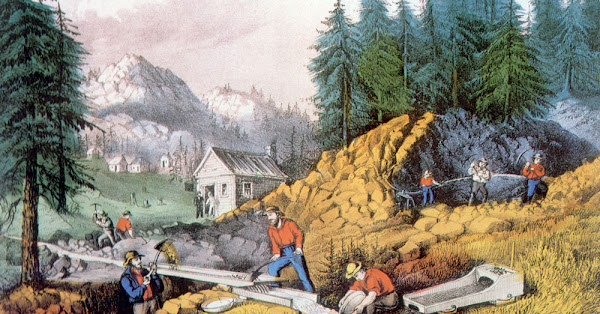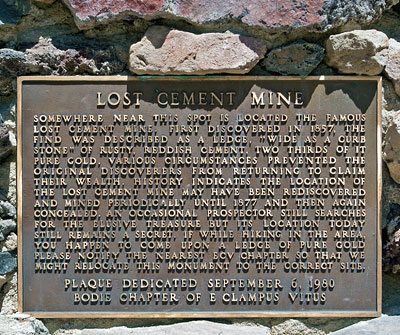
The Cement Gold Mine: California’s Buried Treasure and Enduring Debate
In the rugged, pine-scented hills of California’s Gold Country, where the whisper of history mingles with the rustle of modern life, lies a paradox etched deep into the earth: the Cement Gold Mine. Not a quarry for construction material, as its name might suggest, but one of the deepest and richest hard-rock gold mines in North America. Officially known as the Idaho-Maryland Mine, this subterranean labyrinth in Nevada County is a testament to California’s insatiable pursuit of gold, a pursuit that shaped its destiny, fueled its growth, and continues, even today, to ignite passionate debate.
The moniker "Cement Mine," while perhaps evoking images of construction, actually referred to the exceedingly hard, quartz-rich conglomerate ore that defied early prospectors and required Herculean efforts to extract. It was a gold mine that demanded grit, ingenuity, and an unwavering belief in the riches hidden within the seemingly impenetrable rock. Today, this historic site stands at the epicenter of a fierce modern-day battle, pitting economic revival against environmental preservation, and the echoes of the past against the demands of the future.
A Vein of History: From Placer to Lode

California’s identity is inextricably linked to the Gold Rush of 1849. Initially, the lure was surface gold – flakes and nuggets easily panned from rivers and streams. But as the easily accessible placer deposits dwindled, prospectors turned their attention to the "mother lode," the underground quartz veins from which the gold originated. This shift marked the beginning of hard-rock mining, a far more complex, dangerous, and capital-intensive endeavor.
The Idaho-Maryland Mine emerged as a titan in this new era. Its origins trace back to the mid-1860s, a time when Grass Valley and Nevada City were burgeoning mining towns. Over the next several decades, through various ownerships and consolidations, the mine grew in scale and sophistication. By the early 20th century, it had become a powerhouse, one of the most productive underground gold mines in the United States. Miners descended thousands of feet into the earth, following intricate veins of quartz laced with glittering gold.
Life in and around the Cement Mine was a unique blend of hardship and hope. Miners, often immigrants from around the world, toiled in dark, damp, and dangerous conditions, facing the constant threat of cave-ins, silicosis (miner’s lung disease from silica dust), and explosions. Their days were long, their pay meager by modern standards, but the promise of striking a rich vein, of a "glory hole," kept the spirit alive. Communities like Grass Valley thrived on the mine’s output, with local businesses, schools, and families all interconnected with its fortunes.
The Golden Years: A Production Behemoth
The Idaho-Maryland’s peak production spanned from the 1920s through the early 1940s. It was during this period that the mine achieved legendary status for its depth and output. At its deepest, the main shaft plunged over 3,000 feet, with miles of tunnels branching out like a subterranean spiderweb. Miners worked veins that were sometimes just inches thick but incredibly rich in gold.
- Interesting Fact: By the time of its closure, the Idaho-Maryland Mine had produced an estimated 2.4 million ounces of gold. At today’s prices, that would be worth billions of dollars. This staggering output solidified its place as one of California’s most significant gold producers, second only to the legendary Empire Mine, also in Grass Valley.

The gold extracted from the Cement Mine contributed significantly to the national economy, especially during the Great Depression, when gold was a stable commodity and mining provided much-needed employment. The mine employed hundreds of men, supporting thousands more indirectly. It was a pulsating heart of the region, its rhythmic drills and blasting echoing deep beneath the pastoral landscape, a constant reminder of the wealth being pulled from the earth.
The Quiet Demise: War and Economic Shifts
The golden era of the Idaho-Maryland Mine, like many others, came to an abrupt halt during World War II. In 1942, the War Production Board issued Order L-208, deeming gold mining non-essential to the war effort. Resources, labor, and equipment were diverted to support the production of vital war materials. For the Cement Mine, this order was a death knell. Production ceased, pumps were turned off, and the lower levels of the mine began to flood.
After the war, attempts were made to restart operations, but the economic landscape had changed irrevocably. Rising operating costs, the fixed price of gold (until the 1970s), and the sheer expense of dewatering and rehabilitating such a deep mine proved insurmountable. In 1956, the Idaho-Maryland Mine closed its gates for good, its tunnels left to the silence and the encroaching groundwater. For over 70 years, the Cement Gold Mine lay dormant, a subterranean ghost town, its shafts capped, its entrances sealed, and its rich history slowly fading into local lore.
A Sleeping Giant Awakens: The Modern Proposal
For decades, the Cement Gold Mine was a relic, a fascinating footnote in California’s history. But the rising price of gold in the 21st century, coupled with advancements in mining technology, reignited interest in its untapped potential. Geologists and mining companies knew that the mine had closed not because it ran out of gold, but because of economic and political pressures. Vast reserves were believed to still lie within its quartz veins.
This belief led to the emergence of a new player: Rise Gold Corp., a Canadian mining company. In the late 2010s, Rise Gold began the arduous process of seeking permits to reopen the Idaho-Maryland Mine. Their proposal is ambitious: to dewater the old workings, sink new, modern shafts, and employ state-of-the-art mining techniques to extract the estimated millions of ounces of gold still buried within the earth.
Proponents of the reopening paint a picture of revitalization. They argue that the mine would bring hundreds of high-paying jobs to Nevada County, injecting millions of dollars into the local economy through taxes, wages, and ancillary businesses. They emphasize that modern mining is vastly different from the operations of a century ago, with stricter environmental regulations, advanced safety protocols, and technologies designed to minimize impact. "This isn’t your grandfather’s mine," one Rise Gold spokesperson might contend, "we’re talking about a 21st-century operation with a commitment to responsible mining." For many, the prospect of economic prosperity and the return of a historic industry is a powerful draw.
The Battle for Grass Valley: Economic Hope vs. Environmental Fear
However, the proposed reopening of the Cement Gold Mine has unleashed a torrent of opposition from local residents, environmental groups, and community activists. For those who have made Nevada County their home, attracted by its natural beauty, rural charm, and quiet lifestyle, the idea of an active industrial gold mine operating in their backyard is deeply unsettling.
The concerns are multifaceted and deeply felt:
- Water Quality and Quantity: Opponents fear the impact on local groundwater. Dewatering the mine could affect wells, and the discharge of treated mine water into local waterways like Wolf Creek raises concerns about potential contamination, even with stringent treatment protocols. "Our community relies on clean water," states a representative from a local environmental group, "and the risks associated with dewatering and discharging millions of gallons of mine water are simply too high."
- Noise and Traffic: A fully operational mine would mean constant activity: heavy truck traffic on rural roads, machinery noise, and potentially blasting. This would drastically alter the serene character of the area, impacting property values and quality of life.
- Dust and Air Quality: Mining operations can generate significant dust, raising concerns about air quality and potential health impacts on nearby residents.
- Habitat Destruction: The construction of new facilities, waste rock piles, and infrastructure could impact local ecosystems and wildlife habitats.
- Community Character: Many residents argue that a large-scale industrial mine is incompatible with the community’s vision for itself as a historic, artistic, and agricultural hub. They fear that the mine would forever change the fabric of Grass Valley and Nevada City.
The debate has become a focal point for local politics, with heated public meetings, extensive environmental impact reports (EIRs) stretching thousands of pages, and legal challenges. "We moved here for the peace and quiet, not for a mining operation in our backyard," one local resident, Sarah Jenkins, voiced during a community forum, echoing the sentiments of many who feel their way of life is under threat. The controversy highlights a fundamental tension: how do communities balance the desire for economic growth with the preservation of their environment and unique character?
An Enduring Legacy, An Uncertain Future
The saga of the Cement Gold Mine is a microcosm of a larger, global debate about resource extraction, sustainability, and the legacy of industrialization. It forces us to confront difficult questions: What is the true cost of gold? How much risk are we willing to accept for economic gain? And what kind of future do we envision for places steeped in such a rich, yet complex, history?
As the dust settles on countless public meetings and the legal battles unfold, one thing is clear: the Cement Gold Mine, whether dormant or revived, will continue to shape the destiny of Nevada County. It stands as a testament to California’s enduring, complex relationship with its golden past – a past that unearthed immense wealth, created vibrant communities, and left behind both a powerful legacy and a challenging inheritance. The future of this "cement" gold mine remains buried, for now, in the layers of environmental studies, legal arguments, and the passionate voices of a community grappling with its identity.


